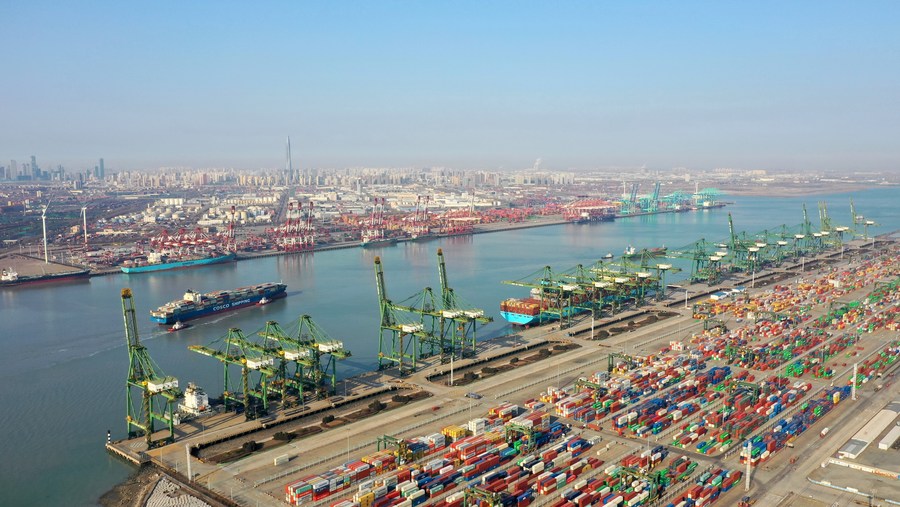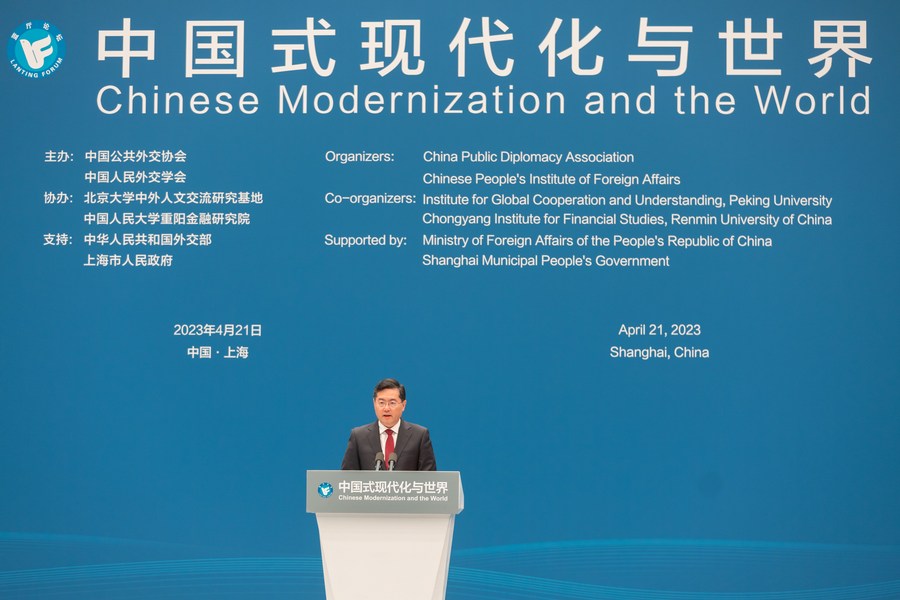

This aerial photo taken on Jan. 10, 2023 shows a container terminal at the Tianjin Port in north China's Tianjin. (Xinhua/Zhao Zishuo)
Modernization. What is it? How is it defined? And by whom? Although it may appear a simple concept, many find it quite complex. Consequently, there has been significant academic interest in unraveling the mysteries surrounding it.
Though their attempts vary in terms of philosophical presuppositions, all their definitions converge at a common understanding: "It characterizes the urge for change." Therefore, the word refers to "a process by which the old social, economic and psychological elements are transformed, and new social values of human conduct are set up."
However, according to advanced capitalist countries, the definition of modernization is the global process by which traditional societies shift to modern societies. That was based on the new world leadership role taken by the United States after World War II. It implied that the United States is modern and advanced and needs to be copied by countries considered traditional.
Currently, it is referred to as Western-style modernization, used to undermine the culture and beliefs of other countries. For example, Paris still controls some economies in the developing world, mainly Francophone countries.
On April 21, 2023, the Lanting Forum on Chinese Modernization and the World was held at the Meet-the-World Lounge in Shanghai. The context of Chinese modernization under the Communist Party of China (CPC) was to modernize China using a modernization model with Chinese characteristics. It is a political slogan championed by the CPC as an alternative model to Western-style development, emphasizing the strengths of the Chinese economic and political model.

Chinese State Councilor and Foreign Minister Qin Gang delivers a speech during the Lanting Forum on Chinese Modernization and the World in Shanghai, east China, April 21, 2023. (Xinhua/Wang Xiang)
Therefore, it is a natural pre-requisite aimed at reviving China in all aspects while naturally allowing human development laws to come to the fore. This model is anchored on five characteristics: a massive population, common prosperity for all, material and cultural-ethical advancement, harmony between humanity and nature, and peaceful development.
The modernization of China in a Chinese style holds significance worldwide because it possesses globally common characteristics. While its unique features are specific to China, it inspires the world. It was developed based on China's national conditions and can be adapted to suit individual countries' paths toward progress.
Its achievements imply that modernization does not equate to Westernization since every country has an opportunity to chart a modernization path that suits its circumstances. For example, China has successfully eradicated absolute poverty and built a moderately prosperous society in all respects by adopting an approach tailored to its own national conditions. This is a great inspiration, especially to developing countries that heavily rely on Western-style modernization without much success. They can be motivated to chart their own paths in reducing poverty and promoting economic development and prosperity.
According to a Kenya-based international relations scholar, China's modernization path was developed for a vast population and has value for its people. Yet, it could inspire developing countries with a small population of just a few million. The argument is: If China can do it for over a billion people, what about those with just a few million?
Chinese modernization has introduced a novel approach to human development, offering valuable options for developing nations to achieve modernization uniquely.

An industry robot works at the analysis and testing center of Konfoong Materials International Co., Ltd. in Ningbo, east China's Zhejiang Province, March 21, 2023. (Xinhua/Weng Xinyang)
Considering Chinese modernization as a driving force for global prosperity is wise.
For example, Hamdi Tabbaa, president of the Jordanian Businessmen Association, drew insights from Chinese modernization, especially in their automobile and insurance sectors and has greatly benefited from China's opening-up and robust growth. Chinese modernization "means better living standards of the Chinese people in the future and will vigorously promote prolonged prosperity and development of the world economy," Tabbaa said.
China's market has expanded, increasing the demand for high-quality goods and services and making global enterprises more attractive. Moreover, China promotes shared prosperity for all and strives for social fairness and justice. This developmental path increases productivity, prosperous lives and a sound ecological environment.
Thus, Chinese modernization is not at the expense of the environment but strives to create sustainable, greener development. Critical examples include efforts to reduce carbon emission intensity with the ambitious goals of achieving carbon peak before 2030 and carbon neutrality before 2060. Furthermore, China is focused on mitigating climate change impacts by 2060. This is a great move that the world should applaud since it is fighting a menace that contributes heavily to food insecurity.
Chinese modernization means better global governance. Therefore, Chinese modernization wishes to use Chinese thinking to bring peace and prosperity to the world. This will help eliminate misunderstandings among nations and allow the world to develop together.
China intends to provide a more equitable development path by sharing its opportunities and experiences. This will highly impact the world, especially developing countries that have always equated modernization to Westernization. For example, the world can see how China values people's health and livelihoods. It could study the strategies that boost science and education, global security, and peace and stability.
China will share its development opportunities and experiences with less developed nations to help them grow, raise living standards and promote building a community with a shared future for humankind. That, in effect, is Chinese-style modernization.
Mohammed Ahmed Awil is former Federal Republic of Somalia Ambassador to the People's Republic of China.
The first training camp of the Center of Innovation and Maritime Excellence, supported by Chinese companies, was opened Thursday in Djibouti City, the capital o...